Diabetes Management in Indigenous People: A Comprehensive Report
VerifiedAdded on 2021/04/24
|12
|3402
|433
Report
AI Summary
This report addresses the critical issue of diabetes management within indigenous populations, highlighting the disproportionately high prevalence of the disease among Aboriginal and Torres Strait Islander peoples compared to non-indigenous populations. It explores the historical context, socioeconomic factors, and lifestyle changes that have contributed to this health disparity. The report identifies key issues faced by this cohort, including lack of health literacy, limited access to healthy foods, and inadequate healthcare access. It proposes a multi-faceted approach involving the formation of a dedicated group of healthcare professionals, including educators, lifestyle modification specialists, and social advocates, to implement initiatives such as health risk assessments, culturally sensitive health education programs, lifestyle modification programs, and social support activities. The report outlines the structure and roles within the proposed group, emphasizing the importance of community engagement, cultural sensitivity, and ongoing evaluation to ensure the effectiveness of the interventions. It also discusses potential challenges and proposes strategies for overcoming them, ultimately aiming to improve the quality of life and reduce the burden of diabetes within indigenous communities.
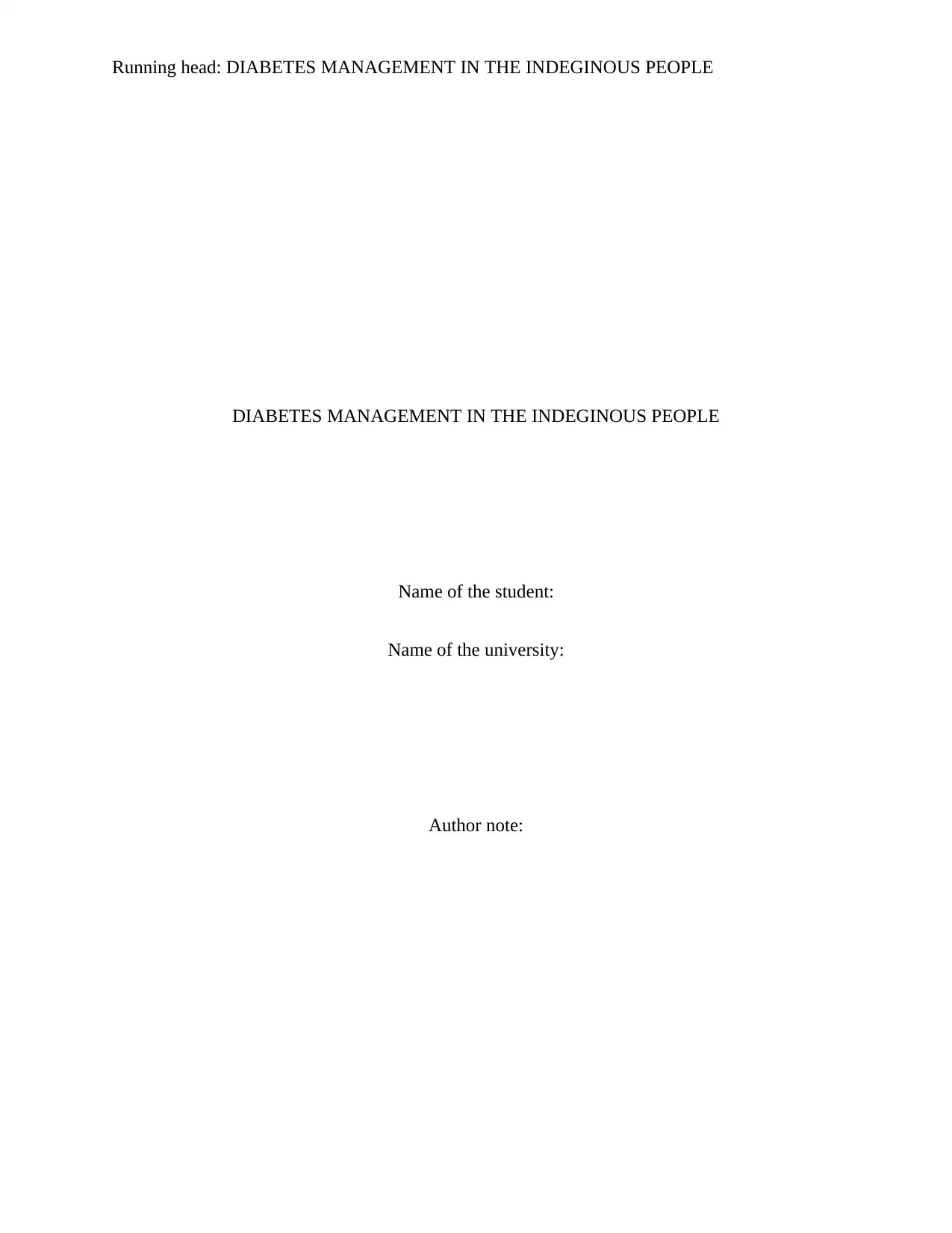
Running head: DIABETES MANAGEMENT IN THE INDEGINOUS PEOPLE
DIABETES MANAGEMENT IN THE INDEGINOUS PEOPLE
Name of the student:
Name of the university:
Author note:
DIABETES MANAGEMENT IN THE INDEGINOUS PEOPLE
Name of the student:
Name of the university:
Author note:
Paraphrase This Document
Need a fresh take? Get an instant paraphrase of this document with our AI Paraphraser
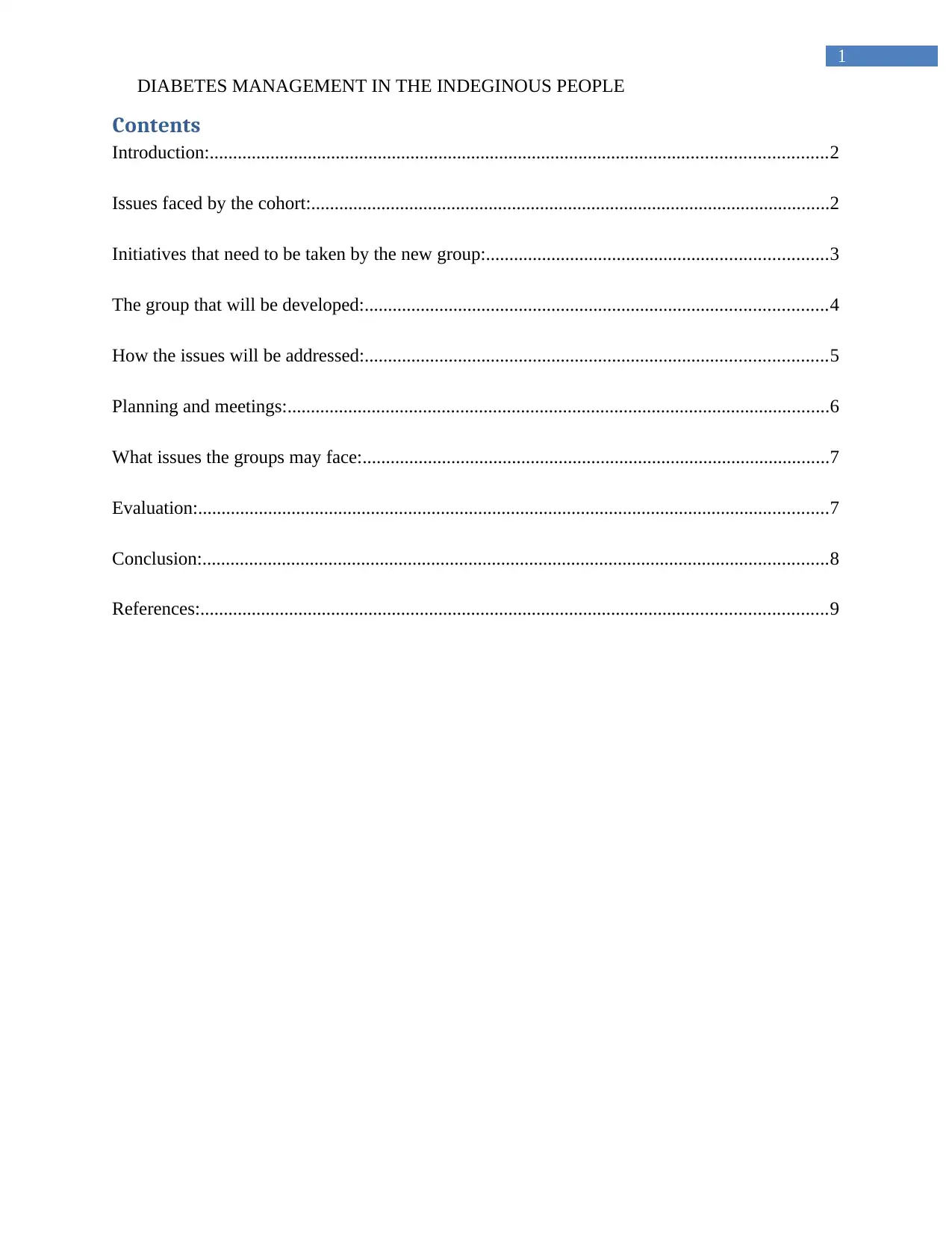
1
DIABETES MANAGEMENT IN THE INDEGINOUS PEOPLE
Contents
Introduction:....................................................................................................................................2
Issues faced by the cohort:...............................................................................................................2
Initiatives that need to be taken by the new group:.........................................................................3
The group that will be developed:...................................................................................................4
How the issues will be addressed:...................................................................................................5
Planning and meetings:....................................................................................................................6
What issues the groups may face:....................................................................................................7
Evaluation:.......................................................................................................................................7
Conclusion:......................................................................................................................................8
References:......................................................................................................................................9
DIABETES MANAGEMENT IN THE INDEGINOUS PEOPLE
Contents
Introduction:....................................................................................................................................2
Issues faced by the cohort:...............................................................................................................2
Initiatives that need to be taken by the new group:.........................................................................3
The group that will be developed:...................................................................................................4
How the issues will be addressed:...................................................................................................5
Planning and meetings:....................................................................................................................6
What issues the groups may face:....................................................................................................7
Evaluation:.......................................................................................................................................7
Conclusion:......................................................................................................................................8
References:......................................................................................................................................9
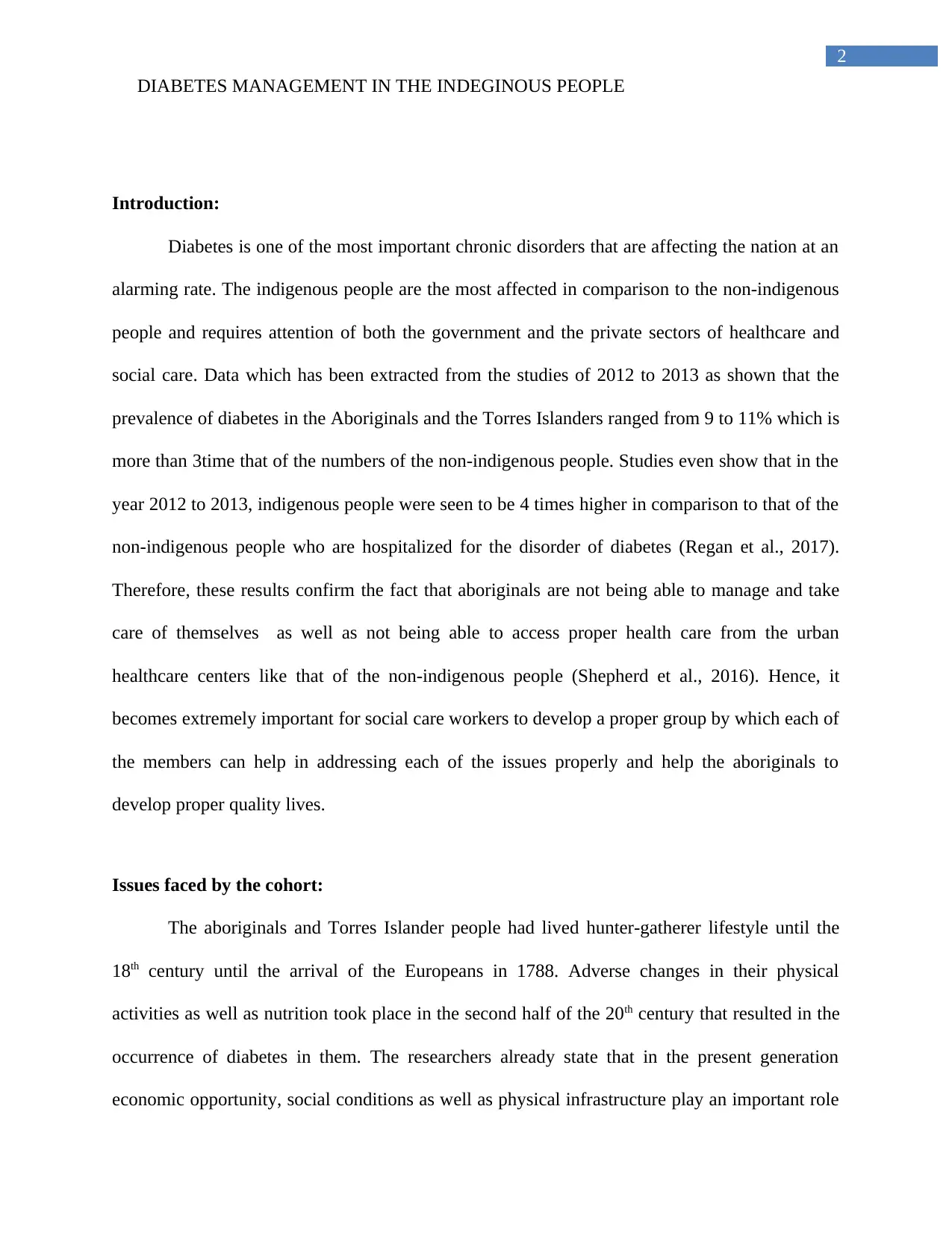
2
DIABETES MANAGEMENT IN THE INDEGINOUS PEOPLE
Introduction:
Diabetes is one of the most important chronic disorders that are affecting the nation at an
alarming rate. The indigenous people are the most affected in comparison to the non-indigenous
people and requires attention of both the government and the private sectors of healthcare and
social care. Data which has been extracted from the studies of 2012 to 2013 as shown that the
prevalence of diabetes in the Aboriginals and the Torres Islanders ranged from 9 to 11% which is
more than 3time that of the numbers of the non-indigenous people. Studies even show that in the
year 2012 to 2013, indigenous people were seen to be 4 times higher in comparison to that of the
non-indigenous people who are hospitalized for the disorder of diabetes (Regan et al., 2017).
Therefore, these results confirm the fact that aboriginals are not being able to manage and take
care of themselves as well as not being able to access proper health care from the urban
healthcare centers like that of the non-indigenous people (Shepherd et al., 2016). Hence, it
becomes extremely important for social care workers to develop a proper group by which each of
the members can help in addressing each of the issues properly and help the aboriginals to
develop proper quality lives.
Issues faced by the cohort:
The aboriginals and Torres Islander people had lived hunter-gatherer lifestyle until the
18th century until the arrival of the Europeans in 1788. Adverse changes in their physical
activities as well as nutrition took place in the second half of the 20th century that resulted in the
occurrence of diabetes in them. The researchers already state that in the present generation
economic opportunity, social conditions as well as physical infrastructure play an important role
DIABETES MANAGEMENT IN THE INDEGINOUS PEOPLE
Introduction:
Diabetes is one of the most important chronic disorders that are affecting the nation at an
alarming rate. The indigenous people are the most affected in comparison to the non-indigenous
people and requires attention of both the government and the private sectors of healthcare and
social care. Data which has been extracted from the studies of 2012 to 2013 as shown that the
prevalence of diabetes in the Aboriginals and the Torres Islanders ranged from 9 to 11% which is
more than 3time that of the numbers of the non-indigenous people. Studies even show that in the
year 2012 to 2013, indigenous people were seen to be 4 times higher in comparison to that of the
non-indigenous people who are hospitalized for the disorder of diabetes (Regan et al., 2017).
Therefore, these results confirm the fact that aboriginals are not being able to manage and take
care of themselves as well as not being able to access proper health care from the urban
healthcare centers like that of the non-indigenous people (Shepherd et al., 2016). Hence, it
becomes extremely important for social care workers to develop a proper group by which each of
the members can help in addressing each of the issues properly and help the aboriginals to
develop proper quality lives.
Issues faced by the cohort:
The aboriginals and Torres Islander people had lived hunter-gatherer lifestyle until the
18th century until the arrival of the Europeans in 1788. Adverse changes in their physical
activities as well as nutrition took place in the second half of the 20th century that resulted in the
occurrence of diabetes in them. The researchers already state that in the present generation
economic opportunity, social conditions as well as physical infrastructure play an important role
⊘ This is a preview!⊘
Do you want full access?
Subscribe today to unlock all pages.

Trusted by 1+ million students worldwide
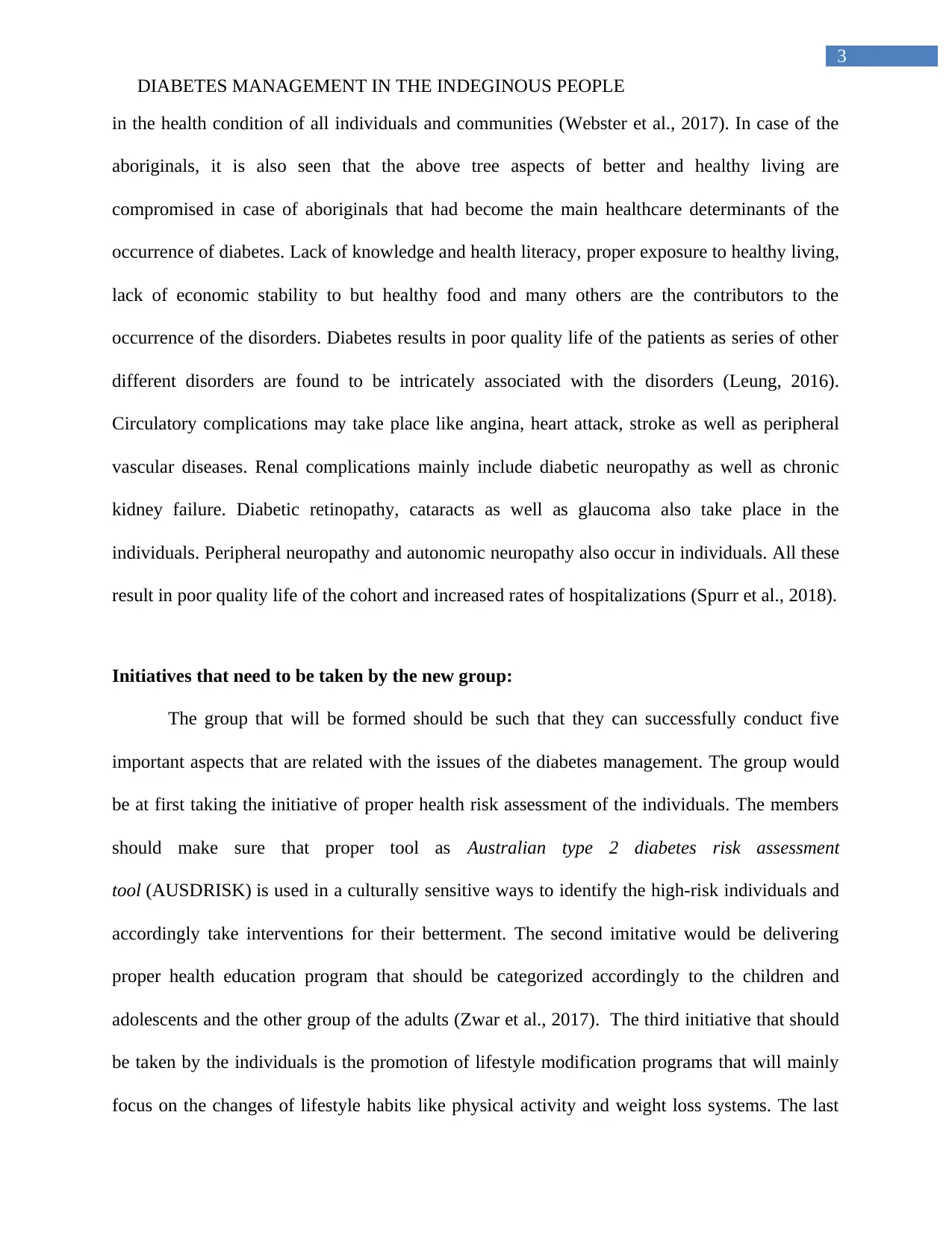
3
DIABETES MANAGEMENT IN THE INDEGINOUS PEOPLE
in the health condition of all individuals and communities (Webster et al., 2017). In case of the
aboriginals, it is also seen that the above tree aspects of better and healthy living are
compromised in case of aboriginals that had become the main healthcare determinants of the
occurrence of diabetes. Lack of knowledge and health literacy, proper exposure to healthy living,
lack of economic stability to but healthy food and many others are the contributors to the
occurrence of the disorders. Diabetes results in poor quality life of the patients as series of other
different disorders are found to be intricately associated with the disorders (Leung, 2016).
Circulatory complications may take place like angina, heart attack, stroke as well as peripheral
vascular diseases. Renal complications mainly include diabetic neuropathy as well as chronic
kidney failure. Diabetic retinopathy, cataracts as well as glaucoma also take place in the
individuals. Peripheral neuropathy and autonomic neuropathy also occur in individuals. All these
result in poor quality life of the cohort and increased rates of hospitalizations (Spurr et al., 2018).
Initiatives that need to be taken by the new group:
The group that will be formed should be such that they can successfully conduct five
important aspects that are related with the issues of the diabetes management. The group would
be at first taking the initiative of proper health risk assessment of the individuals. The members
should make sure that proper tool as Australian type 2 diabetes risk assessment
tool (AUSDRISK) is used in a culturally sensitive ways to identify the high-risk individuals and
accordingly take interventions for their betterment. The second imitative would be delivering
proper health education program that should be categorized accordingly to the children and
adolescents and the other group of the adults (Zwar et al., 2017). The third initiative that should
be taken by the individuals is the promotion of lifestyle modification programs that will mainly
focus on the changes of lifestyle habits like physical activity and weight loss systems. The last
DIABETES MANAGEMENT IN THE INDEGINOUS PEOPLE
in the health condition of all individuals and communities (Webster et al., 2017). In case of the
aboriginals, it is also seen that the above tree aspects of better and healthy living are
compromised in case of aboriginals that had become the main healthcare determinants of the
occurrence of diabetes. Lack of knowledge and health literacy, proper exposure to healthy living,
lack of economic stability to but healthy food and many others are the contributors to the
occurrence of the disorders. Diabetes results in poor quality life of the patients as series of other
different disorders are found to be intricately associated with the disorders (Leung, 2016).
Circulatory complications may take place like angina, heart attack, stroke as well as peripheral
vascular diseases. Renal complications mainly include diabetic neuropathy as well as chronic
kidney failure. Diabetic retinopathy, cataracts as well as glaucoma also take place in the
individuals. Peripheral neuropathy and autonomic neuropathy also occur in individuals. All these
result in poor quality life of the cohort and increased rates of hospitalizations (Spurr et al., 2018).
Initiatives that need to be taken by the new group:
The group that will be formed should be such that they can successfully conduct five
important aspects that are related with the issues of the diabetes management. The group would
be at first taking the initiative of proper health risk assessment of the individuals. The members
should make sure that proper tool as Australian type 2 diabetes risk assessment
tool (AUSDRISK) is used in a culturally sensitive ways to identify the high-risk individuals and
accordingly take interventions for their betterment. The second imitative would be delivering
proper health education program that should be categorized accordingly to the children and
adolescents and the other group of the adults (Zwar et al., 2017). The third initiative that should
be taken by the individuals is the promotion of lifestyle modification programs that will mainly
focus on the changes of lifestyle habits like physical activity and weight loss systems. The last
Paraphrase This Document
Need a fresh take? Get an instant paraphrase of this document with our AI Paraphraser

4
DIABETES MANAGEMENT IN THE INDEGINOUS PEOPLE
factor that should be taken is proper evaluation strategies by which the members of the groups
can assess the results of the initiatives taken and accordingly try their best to help the individuals
overcome the disorders. Besides, some members of the group have to take the responsibility of
advocating and trying their best to manage the issues through miscellaneous social activities
properly (Nguyen et al., 2016). These might include arrangement of proper medications,
advocating for their needs to the local government, arranging for resources, conveying concerns
of the aboriginals to the governments and so on.
The group that will be developed:
The group that will be developed will have 20 members who will be addressing the
different sections of the initiatives that will be taken for management of diabetes among the
cohort. 5 diabetic educators would be introduced into the group out of which two of them would
be mainly addressing the education of the children and adolescents. These two educators will be
chosen such that they remain well knowledgeable about the communication styles and cognitive
power analysis of such children and adolescents (Marley et al., 2015). The rest 3 of the educators
old be mainly addressing the education plans of the adults making them develop heath literacy so
that they can change required habits for better living. Four of the embers out of the 20 member
team would take upon the responsibility to conduct the lifestyle modification programs. Here,
they will urge all the community members to participate and help them develop knowledge about
lifestyle modification through simple community programs. This would include activities like
physical exercise programs, swimming sessions in the form of sports, help them learn how to
measure blood glucose properly without assistance of health professionals and others (Scienerout
et al., 2016). Six of the members would be mainly conducting the social activities and advocate
effectively for the different necessities which would support the aboriginals to overcome the
DIABETES MANAGEMENT IN THE INDEGINOUS PEOPLE
factor that should be taken is proper evaluation strategies by which the members of the groups
can assess the results of the initiatives taken and accordingly try their best to help the individuals
overcome the disorders. Besides, some members of the group have to take the responsibility of
advocating and trying their best to manage the issues through miscellaneous social activities
properly (Nguyen et al., 2016). These might include arrangement of proper medications,
advocating for their needs to the local government, arranging for resources, conveying concerns
of the aboriginals to the governments and so on.
The group that will be developed:
The group that will be developed will have 20 members who will be addressing the
different sections of the initiatives that will be taken for management of diabetes among the
cohort. 5 diabetic educators would be introduced into the group out of which two of them would
be mainly addressing the education of the children and adolescents. These two educators will be
chosen such that they remain well knowledgeable about the communication styles and cognitive
power analysis of such children and adolescents (Marley et al., 2015). The rest 3 of the educators
old be mainly addressing the education plans of the adults making them develop heath literacy so
that they can change required habits for better living. Four of the embers out of the 20 member
team would take upon the responsibility to conduct the lifestyle modification programs. Here,
they will urge all the community members to participate and help them develop knowledge about
lifestyle modification through simple community programs. This would include activities like
physical exercise programs, swimming sessions in the form of sports, help them learn how to
measure blood glucose properly without assistance of health professionals and others (Scienerout
et al., 2016). Six of the members would be mainly conducting the social activities and advocate
effectively for the different necessities which would support the aboriginals to overcome the
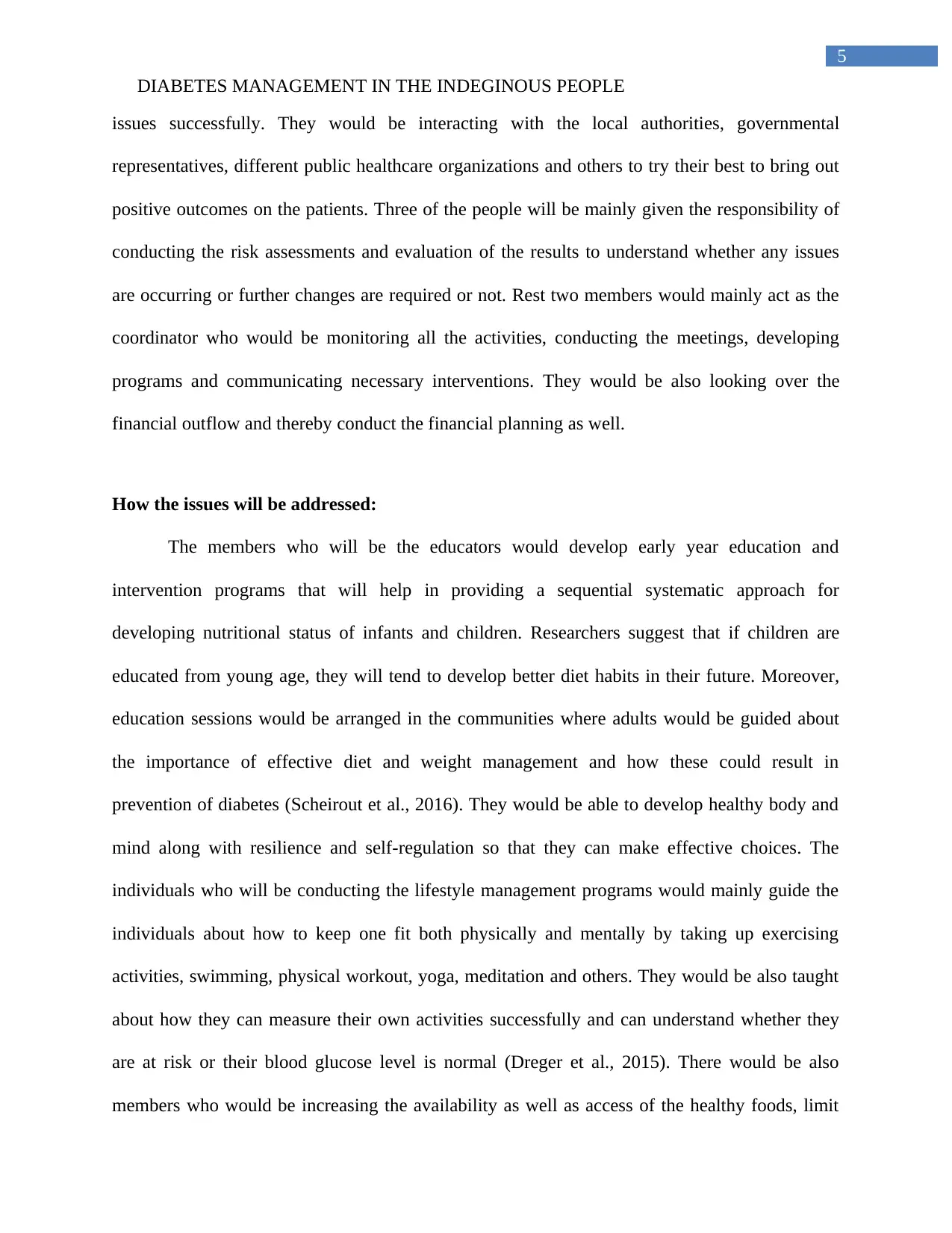
5
DIABETES MANAGEMENT IN THE INDEGINOUS PEOPLE
issues successfully. They would be interacting with the local authorities, governmental
representatives, different public healthcare organizations and others to try their best to bring out
positive outcomes on the patients. Three of the people will be mainly given the responsibility of
conducting the risk assessments and evaluation of the results to understand whether any issues
are occurring or further changes are required or not. Rest two members would mainly act as the
coordinator who would be monitoring all the activities, conducting the meetings, developing
programs and communicating necessary interventions. They would be also looking over the
financial outflow and thereby conduct the financial planning as well.
How the issues will be addressed:
The members who will be the educators would develop early year education and
intervention programs that will help in providing a sequential systematic approach for
developing nutritional status of infants and children. Researchers suggest that if children are
educated from young age, they will tend to develop better diet habits in their future. Moreover,
education sessions would be arranged in the communities where adults would be guided about
the importance of effective diet and weight management and how these could result in
prevention of diabetes (Scheirout et al., 2016). They would be able to develop healthy body and
mind along with resilience and self-regulation so that they can make effective choices. The
individuals who will be conducting the lifestyle management programs would mainly guide the
individuals about how to keep one fit both physically and mentally by taking up exercising
activities, swimming, physical workout, yoga, meditation and others. They would be also taught
about how they can measure their own activities successfully and can understand whether they
are at risk or their blood glucose level is normal (Dreger et al., 2015). There would be also
members who would be increasing the availability as well as access of the healthy foods, limit
DIABETES MANAGEMENT IN THE INDEGINOUS PEOPLE
issues successfully. They would be interacting with the local authorities, governmental
representatives, different public healthcare organizations and others to try their best to bring out
positive outcomes on the patients. Three of the people will be mainly given the responsibility of
conducting the risk assessments and evaluation of the results to understand whether any issues
are occurring or further changes are required or not. Rest two members would mainly act as the
coordinator who would be monitoring all the activities, conducting the meetings, developing
programs and communicating necessary interventions. They would be also looking over the
financial outflow and thereby conduct the financial planning as well.
How the issues will be addressed:
The members who will be the educators would develop early year education and
intervention programs that will help in providing a sequential systematic approach for
developing nutritional status of infants and children. Researchers suggest that if children are
educated from young age, they will tend to develop better diet habits in their future. Moreover,
education sessions would be arranged in the communities where adults would be guided about
the importance of effective diet and weight management and how these could result in
prevention of diabetes (Scheirout et al., 2016). They would be able to develop healthy body and
mind along with resilience and self-regulation so that they can make effective choices. The
individuals who will be conducting the lifestyle management programs would mainly guide the
individuals about how to keep one fit both physically and mentally by taking up exercising
activities, swimming, physical workout, yoga, meditation and others. They would be also taught
about how they can measure their own activities successfully and can understand whether they
are at risk or their blood glucose level is normal (Dreger et al., 2015). There would be also
members who would be increasing the availability as well as access of the healthy foods, limit
⊘ This is a preview!⊘
Do you want full access?
Subscribe today to unlock all pages.

Trusted by 1+ million students worldwide
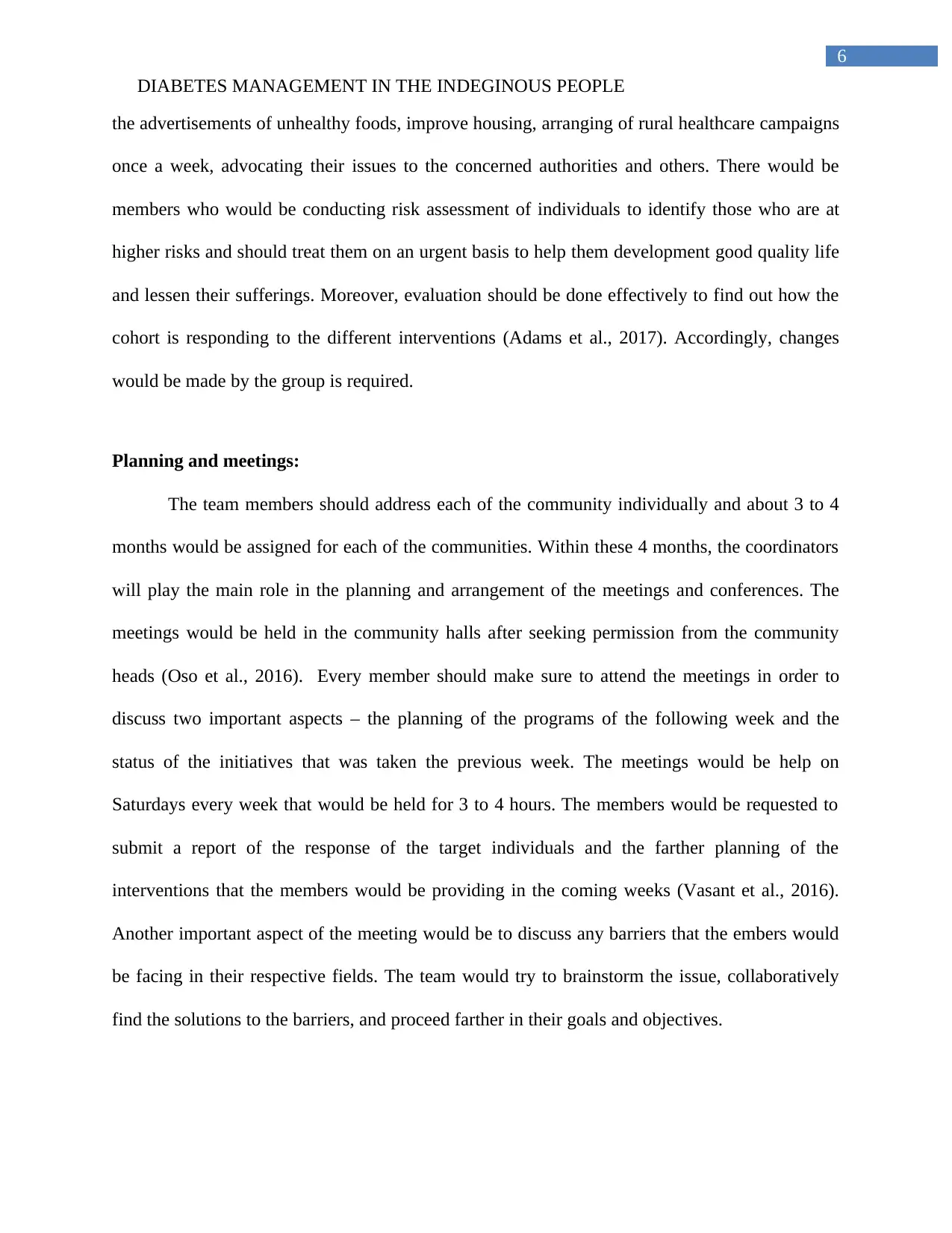
6
DIABETES MANAGEMENT IN THE INDEGINOUS PEOPLE
the advertisements of unhealthy foods, improve housing, arranging of rural healthcare campaigns
once a week, advocating their issues to the concerned authorities and others. There would be
members who would be conducting risk assessment of individuals to identify those who are at
higher risks and should treat them on an urgent basis to help them development good quality life
and lessen their sufferings. Moreover, evaluation should be done effectively to find out how the
cohort is responding to the different interventions (Adams et al., 2017). Accordingly, changes
would be made by the group is required.
Planning and meetings:
The team members should address each of the community individually and about 3 to 4
months would be assigned for each of the communities. Within these 4 months, the coordinators
will play the main role in the planning and arrangement of the meetings and conferences. The
meetings would be held in the community halls after seeking permission from the community
heads (Oso et al., 2016). Every member should make sure to attend the meetings in order to
discuss two important aspects – the planning of the programs of the following week and the
status of the initiatives that was taken the previous week. The meetings would be help on
Saturdays every week that would be held for 3 to 4 hours. The members would be requested to
submit a report of the response of the target individuals and the farther planning of the
interventions that the members would be providing in the coming weeks (Vasant et al., 2016).
Another important aspect of the meeting would be to discuss any barriers that the embers would
be facing in their respective fields. The team would try to brainstorm the issue, collaboratively
find the solutions to the barriers, and proceed farther in their goals and objectives.
DIABETES MANAGEMENT IN THE INDEGINOUS PEOPLE
the advertisements of unhealthy foods, improve housing, arranging of rural healthcare campaigns
once a week, advocating their issues to the concerned authorities and others. There would be
members who would be conducting risk assessment of individuals to identify those who are at
higher risks and should treat them on an urgent basis to help them development good quality life
and lessen their sufferings. Moreover, evaluation should be done effectively to find out how the
cohort is responding to the different interventions (Adams et al., 2017). Accordingly, changes
would be made by the group is required.
Planning and meetings:
The team members should address each of the community individually and about 3 to 4
months would be assigned for each of the communities. Within these 4 months, the coordinators
will play the main role in the planning and arrangement of the meetings and conferences. The
meetings would be held in the community halls after seeking permission from the community
heads (Oso et al., 2016). Every member should make sure to attend the meetings in order to
discuss two important aspects – the planning of the programs of the following week and the
status of the initiatives that was taken the previous week. The meetings would be help on
Saturdays every week that would be held for 3 to 4 hours. The members would be requested to
submit a report of the response of the target individuals and the farther planning of the
interventions that the members would be providing in the coming weeks (Vasant et al., 2016).
Another important aspect of the meeting would be to discuss any barriers that the embers would
be facing in their respective fields. The team would try to brainstorm the issue, collaboratively
find the solutions to the barriers, and proceed farther in their goals and objectives.
Paraphrase This Document
Need a fresh take? Get an instant paraphrase of this document with our AI Paraphraser

7
DIABETES MANAGEMENT IN THE INDEGINOUS PEOPLE
What issues the groups may face:
Aboriginal culture and their different communities are found to be widely diverse. There
are different nations, tribes as well as groups living in the remote regions of Australia who have
their own cultural traditions, preferences and inhibitions. Therefore, if the group applies ‘one size
fits for all’ technique, the goals and objectives would never be met and the aboriginals would
never be able to connect emotionally with the initiatives taken for them. Therefore, members
need to tailor the ways of their working as well as their communication so that the needs of the
communities can be met. Therefore, developing such a varied knowledge of the respective
cultural traditions would be stressful for the members that may affect them physically and be
emotionally tiring (Chung et al., 2014). Moreover, another important factor is that there are many
cultural as well as historical factors that need to be acknowledged by the members, as they would
be working closely with the people. Developing a vast knowledge about the background of the
cohort requires huge time and dedication. It might happen that the members may not be able to
develop such knowledge at one go or may not be able to be culturally sensitive due to the lack of
cultural awareness and sensitivity. This may result in tensions among the members and the
cohort that may lead to the failure of the project. Therefore, members should provide services,
programs and interventions that align with their cultures and provides them scope in active
participation and decision-making.
Evaluation:
The member who has the responsibility to tackle the risk assessment and evaluation parts
would develop a questionnaire. This questionnaire would be circulated in the communities at the
end week of a particular month. The members would be surveying the aboriginals in different
aspects of the programs and how they are perceiving it. The questionnaires should also note
DIABETES MANAGEMENT IN THE INDEGINOUS PEOPLE
What issues the groups may face:
Aboriginal culture and their different communities are found to be widely diverse. There
are different nations, tribes as well as groups living in the remote regions of Australia who have
their own cultural traditions, preferences and inhibitions. Therefore, if the group applies ‘one size
fits for all’ technique, the goals and objectives would never be met and the aboriginals would
never be able to connect emotionally with the initiatives taken for them. Therefore, members
need to tailor the ways of their working as well as their communication so that the needs of the
communities can be met. Therefore, developing such a varied knowledge of the respective
cultural traditions would be stressful for the members that may affect them physically and be
emotionally tiring (Chung et al., 2014). Moreover, another important factor is that there are many
cultural as well as historical factors that need to be acknowledged by the members, as they would
be working closely with the people. Developing a vast knowledge about the background of the
cohort requires huge time and dedication. It might happen that the members may not be able to
develop such knowledge at one go or may not be able to be culturally sensitive due to the lack of
cultural awareness and sensitivity. This may result in tensions among the members and the
cohort that may lead to the failure of the project. Therefore, members should provide services,
programs and interventions that align with their cultures and provides them scope in active
participation and decision-making.
Evaluation:
The member who has the responsibility to tackle the risk assessment and evaluation parts
would develop a questionnaire. This questionnaire would be circulated in the communities at the
end week of a particular month. The members would be surveying the aboriginals in different
aspects of the programs and how they are perceiving it. The questionnaires should also note
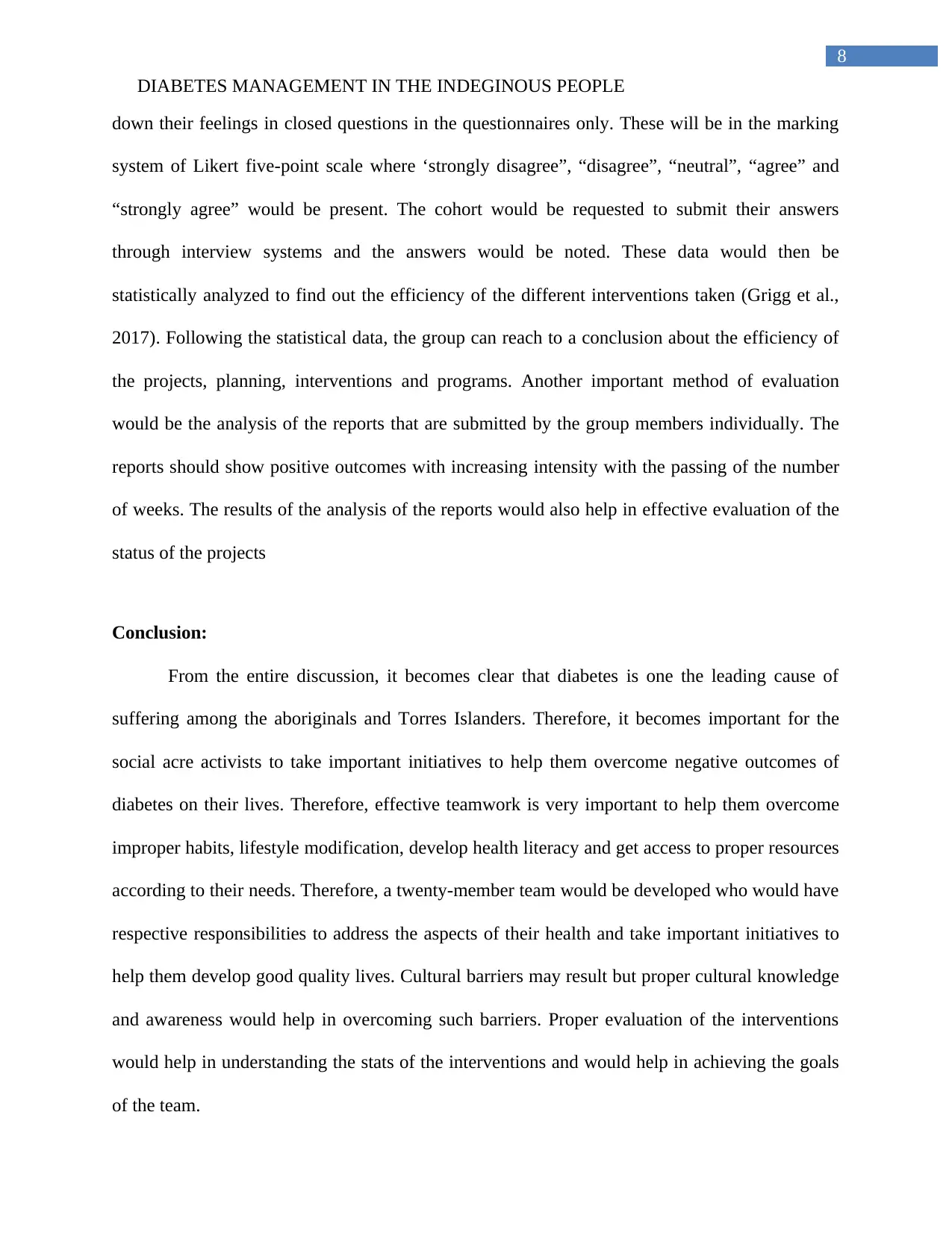
8
DIABETES MANAGEMENT IN THE INDEGINOUS PEOPLE
down their feelings in closed questions in the questionnaires only. These will be in the marking
system of Likert five-point scale where ‘strongly disagree”, “disagree”, “neutral”, “agree” and
“strongly agree” would be present. The cohort would be requested to submit their answers
through interview systems and the answers would be noted. These data would then be
statistically analyzed to find out the efficiency of the different interventions taken (Grigg et al.,
2017). Following the statistical data, the group can reach to a conclusion about the efficiency of
the projects, planning, interventions and programs. Another important method of evaluation
would be the analysis of the reports that are submitted by the group members individually. The
reports should show positive outcomes with increasing intensity with the passing of the number
of weeks. The results of the analysis of the reports would also help in effective evaluation of the
status of the projects
Conclusion:
From the entire discussion, it becomes clear that diabetes is one the leading cause of
suffering among the aboriginals and Torres Islanders. Therefore, it becomes important for the
social acre activists to take important initiatives to help them overcome negative outcomes of
diabetes on their lives. Therefore, effective teamwork is very important to help them overcome
improper habits, lifestyle modification, develop health literacy and get access to proper resources
according to their needs. Therefore, a twenty-member team would be developed who would have
respective responsibilities to address the aspects of their health and take important initiatives to
help them develop good quality lives. Cultural barriers may result but proper cultural knowledge
and awareness would help in overcoming such barriers. Proper evaluation of the interventions
would help in understanding the stats of the interventions and would help in achieving the goals
of the team.
DIABETES MANAGEMENT IN THE INDEGINOUS PEOPLE
down their feelings in closed questions in the questionnaires only. These will be in the marking
system of Likert five-point scale where ‘strongly disagree”, “disagree”, “neutral”, “agree” and
“strongly agree” would be present. The cohort would be requested to submit their answers
through interview systems and the answers would be noted. These data would then be
statistically analyzed to find out the efficiency of the different interventions taken (Grigg et al.,
2017). Following the statistical data, the group can reach to a conclusion about the efficiency of
the projects, planning, interventions and programs. Another important method of evaluation
would be the analysis of the reports that are submitted by the group members individually. The
reports should show positive outcomes with increasing intensity with the passing of the number
of weeks. The results of the analysis of the reports would also help in effective evaluation of the
status of the projects
Conclusion:
From the entire discussion, it becomes clear that diabetes is one the leading cause of
suffering among the aboriginals and Torres Islanders. Therefore, it becomes important for the
social acre activists to take important initiatives to help them overcome negative outcomes of
diabetes on their lives. Therefore, effective teamwork is very important to help them overcome
improper habits, lifestyle modification, develop health literacy and get access to proper resources
according to their needs. Therefore, a twenty-member team would be developed who would have
respective responsibilities to address the aspects of their health and take important initiatives to
help them develop good quality lives. Cultural barriers may result but proper cultural knowledge
and awareness would help in overcoming such barriers. Proper evaluation of the interventions
would help in understanding the stats of the interventions and would help in achieving the goals
of the team.
⊘ This is a preview!⊘
Do you want full access?
Subscribe today to unlock all pages.

Trusted by 1+ million students worldwide
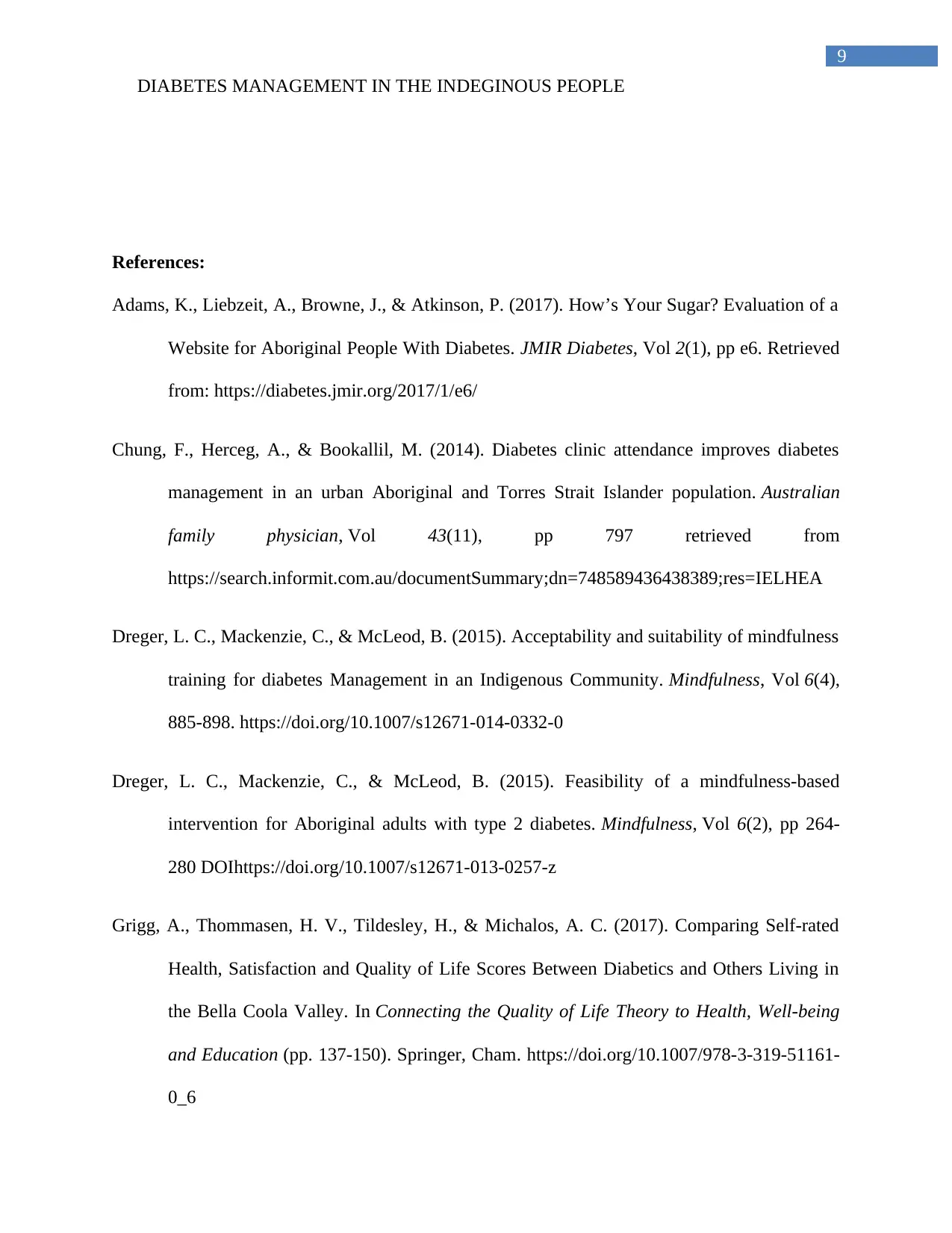
9
DIABETES MANAGEMENT IN THE INDEGINOUS PEOPLE
References:
Adams, K., Liebzeit, A., Browne, J., & Atkinson, P. (2017). How’s Your Sugar? Evaluation of a
Website for Aboriginal People With Diabetes. JMIR Diabetes, Vol 2(1), pp e6. Retrieved
from: https://diabetes.jmir.org/2017/1/e6/
Chung, F., Herceg, A., & Bookallil, M. (2014). Diabetes clinic attendance improves diabetes
management in an urban Aboriginal and Torres Strait Islander population. Australian
family physician, Vol 43(11), pp 797 retrieved from
https://search.informit.com.au/documentSummary;dn=748589436438389;res=IELHEA
Dreger, L. C., Mackenzie, C., & McLeod, B. (2015). Acceptability and suitability of mindfulness
training for diabetes Management in an Indigenous Community. Mindfulness, Vol 6(4),
885-898. https://doi.org/10.1007/s12671-014-0332-0
Dreger, L. C., Mackenzie, C., & McLeod, B. (2015). Feasibility of a mindfulness-based
intervention for Aboriginal adults with type 2 diabetes. Mindfulness, Vol 6(2), pp 264-
280 DOIhttps://doi.org/10.1007/s12671-013-0257-z
Grigg, A., Thommasen, H. V., Tildesley, H., & Michalos, A. C. (2017). Comparing Self-rated
Health, Satisfaction and Quality of Life Scores Between Diabetics and Others Living in
the Bella Coola Valley. In Connecting the Quality of Life Theory to Health, Well-being
and Education (pp. 137-150). Springer, Cham. https://doi.org/10.1007/978-3-319-51161-
0_6
DIABETES MANAGEMENT IN THE INDEGINOUS PEOPLE
References:
Adams, K., Liebzeit, A., Browne, J., & Atkinson, P. (2017). How’s Your Sugar? Evaluation of a
Website for Aboriginal People With Diabetes. JMIR Diabetes, Vol 2(1), pp e6. Retrieved
from: https://diabetes.jmir.org/2017/1/e6/
Chung, F., Herceg, A., & Bookallil, M. (2014). Diabetes clinic attendance improves diabetes
management in an urban Aboriginal and Torres Strait Islander population. Australian
family physician, Vol 43(11), pp 797 retrieved from
https://search.informit.com.au/documentSummary;dn=748589436438389;res=IELHEA
Dreger, L. C., Mackenzie, C., & McLeod, B. (2015). Acceptability and suitability of mindfulness
training for diabetes Management in an Indigenous Community. Mindfulness, Vol 6(4),
885-898. https://doi.org/10.1007/s12671-014-0332-0
Dreger, L. C., Mackenzie, C., & McLeod, B. (2015). Feasibility of a mindfulness-based
intervention for Aboriginal adults with type 2 diabetes. Mindfulness, Vol 6(2), pp 264-
280 DOIhttps://doi.org/10.1007/s12671-013-0257-z
Grigg, A., Thommasen, H. V., Tildesley, H., & Michalos, A. C. (2017). Comparing Self-rated
Health, Satisfaction and Quality of Life Scores Between Diabetics and Others Living in
the Bella Coola Valley. In Connecting the Quality of Life Theory to Health, Well-being
and Education (pp. 137-150). Springer, Cham. https://doi.org/10.1007/978-3-319-51161-
0_6
Paraphrase This Document
Need a fresh take? Get an instant paraphrase of this document with our AI Paraphraser
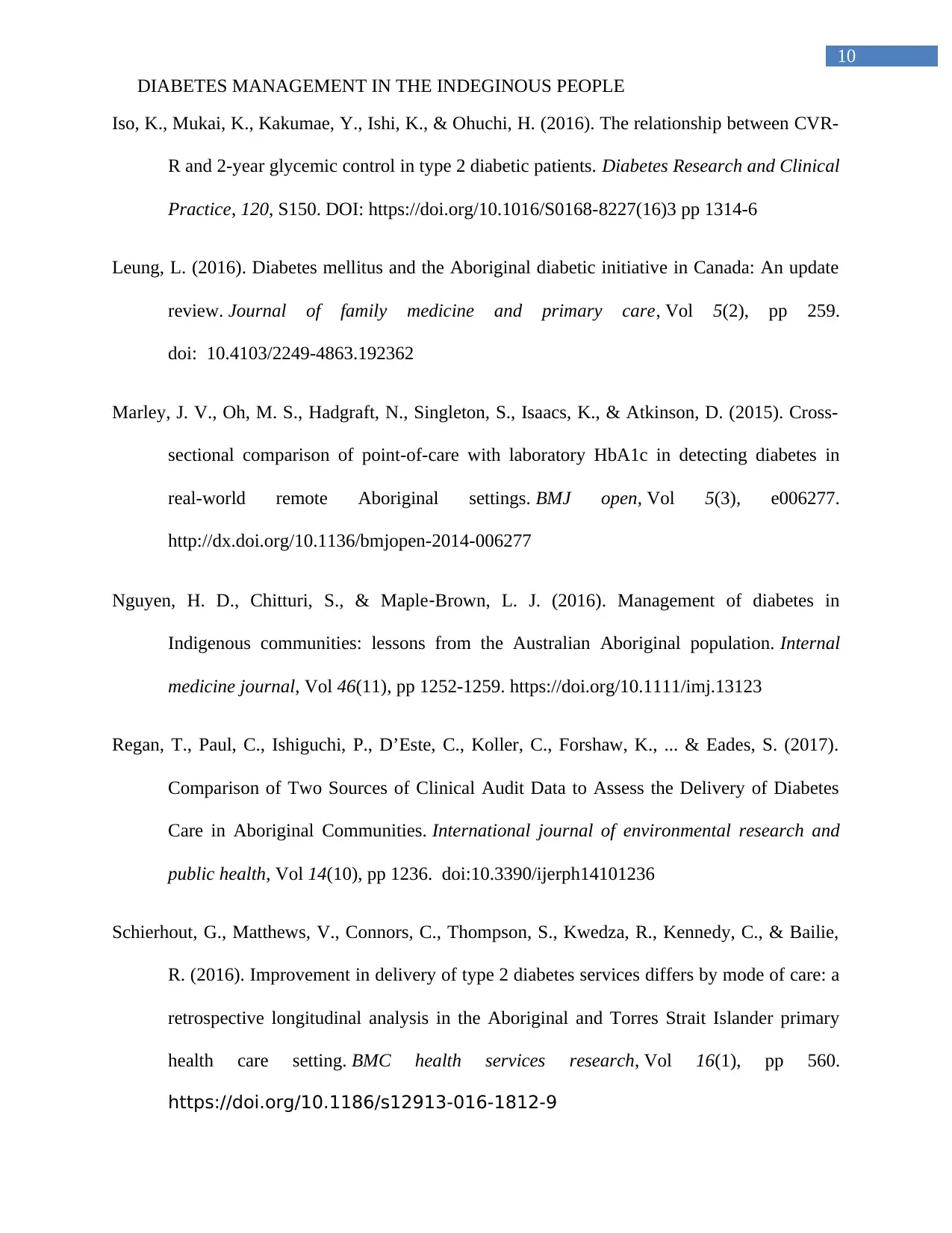
10
DIABETES MANAGEMENT IN THE INDEGINOUS PEOPLE
Iso, K., Mukai, K., Kakumae, Y., Ishi, K., & Ohuchi, H. (2016). The relationship between CVR-
R and 2-year glycemic control in type 2 diabetic patients. Diabetes Research and Clinical
Practice, 120, S150. DOI: https://doi.org/10.1016/S0168-8227(16)3 pp 1314-6
Leung, L. (2016). Diabetes mellitus and the Aboriginal diabetic initiative in Canada: An update
review. Journal of family medicine and primary care, Vol 5(2), pp 259.
doi: 10.4103/2249-4863.192362
Marley, J. V., Oh, M. S., Hadgraft, N., Singleton, S., Isaacs, K., & Atkinson, D. (2015). Cross-
sectional comparison of point-of-care with laboratory HbA1c in detecting diabetes in
real-world remote Aboriginal settings. BMJ open, Vol 5(3), e006277.
http://dx.doi.org/10.1136/bmjopen-2014-006277
Nguyen, H. D., Chitturi, S., & Maple‐Brown, L. J. (2016). Management of diabetes in
Indigenous communities: lessons from the Australian Aboriginal population. Internal
medicine journal, Vol 46(11), pp 1252-1259. https://doi.org/10.1111/imj.13123
Regan, T., Paul, C., Ishiguchi, P., D’Este, C., Koller, C., Forshaw, K., ... & Eades, S. (2017).
Comparison of Two Sources of Clinical Audit Data to Assess the Delivery of Diabetes
Care in Aboriginal Communities. International journal of environmental research and
public health, Vol 14(10), pp 1236. doi:10.3390/ijerph14101236
Schierhout, G., Matthews, V., Connors, C., Thompson, S., Kwedza, R., Kennedy, C., & Bailie,
R. (2016). Improvement in delivery of type 2 diabetes services differs by mode of care: a
retrospective longitudinal analysis in the Aboriginal and Torres Strait Islander primary
health care setting. BMC health services research, Vol 16(1), pp 560.
https://doi.org/10.1186/s12913-016-1812-9
DIABETES MANAGEMENT IN THE INDEGINOUS PEOPLE
Iso, K., Mukai, K., Kakumae, Y., Ishi, K., & Ohuchi, H. (2016). The relationship between CVR-
R and 2-year glycemic control in type 2 diabetic patients. Diabetes Research and Clinical
Practice, 120, S150. DOI: https://doi.org/10.1016/S0168-8227(16)3 pp 1314-6
Leung, L. (2016). Diabetes mellitus and the Aboriginal diabetic initiative in Canada: An update
review. Journal of family medicine and primary care, Vol 5(2), pp 259.
doi: 10.4103/2249-4863.192362
Marley, J. V., Oh, M. S., Hadgraft, N., Singleton, S., Isaacs, K., & Atkinson, D. (2015). Cross-
sectional comparison of point-of-care with laboratory HbA1c in detecting diabetes in
real-world remote Aboriginal settings. BMJ open, Vol 5(3), e006277.
http://dx.doi.org/10.1136/bmjopen-2014-006277
Nguyen, H. D., Chitturi, S., & Maple‐Brown, L. J. (2016). Management of diabetes in
Indigenous communities: lessons from the Australian Aboriginal population. Internal
medicine journal, Vol 46(11), pp 1252-1259. https://doi.org/10.1111/imj.13123
Regan, T., Paul, C., Ishiguchi, P., D’Este, C., Koller, C., Forshaw, K., ... & Eades, S. (2017).
Comparison of Two Sources of Clinical Audit Data to Assess the Delivery of Diabetes
Care in Aboriginal Communities. International journal of environmental research and
public health, Vol 14(10), pp 1236. doi:10.3390/ijerph14101236
Schierhout, G., Matthews, V., Connors, C., Thompson, S., Kwedza, R., Kennedy, C., & Bailie,
R. (2016). Improvement in delivery of type 2 diabetes services differs by mode of care: a
retrospective longitudinal analysis in the Aboriginal and Torres Strait Islander primary
health care setting. BMC health services research, Vol 16(1), pp 560.
https://doi.org/10.1186/s12913-016-1812-9

11
DIABETES MANAGEMENT IN THE INDEGINOUS PEOPLE
Shephard, M., O’Brien, C., Burgoyne, A., Croft, J., Garlett, T., Barancek, K., ... & Shephard, A.
(2016). Review of the cultural safety of a national Indigenous point-of-care testing
program for diabetes management. Australian journal of primary health, Vol 22(4), pp
368-374. https://doi.org/10.1071/PY15050
Spurr, S., Bullin, C., Bally, J., Trinder, K., & Khan, S. (2018). Nurse-led diabetic retinopathy
screening: a pilot study to evaluate a new approach to vision care for Canadian
Aboriginal peoples. International journal of circumpolar health, Vol 77(1), pp 1422670.
https://doi.org/10.1080/22423982.2017.1422670
Vasant, B. R., Matthews, V., Burgess, C. P., Connors, C. M., & Bailie, R. S. (2016). Wide
variation in absolute cardiovascular risk assessment in Aboriginal and Torres Strait
Islander people with Type 2 diabetes. Frontiers in public health, Vol 4, 37.
ttps://doi.org/10.3389/fpubh.2016.00037
Webster, E., Johnson, C., Kemp, B., Smith, V., Johnson, M., & Townsend, B. (2017). Theory
that explains an Aboriginal perspective of learning to understand and manage
diabetes. Australian and New Zealand journal of public health, Vol 41(1), pp 27-31.
https://doi.org/10.1111/1753-6405.12605
Zwar, N., Harris, M., Griffiths, R., Roland, M., Dennis, S., Powell Davies, G., & Hasan, I.
(2017). A systematic review of chronic disease management. retrieved from
https://openresearch
repository.anu.edu.au/bitstream/1885/119226/3/final_25_zwar_pdf_85791.pdf
DIABETES MANAGEMENT IN THE INDEGINOUS PEOPLE
Shephard, M., O’Brien, C., Burgoyne, A., Croft, J., Garlett, T., Barancek, K., ... & Shephard, A.
(2016). Review of the cultural safety of a national Indigenous point-of-care testing
program for diabetes management. Australian journal of primary health, Vol 22(4), pp
368-374. https://doi.org/10.1071/PY15050
Spurr, S., Bullin, C., Bally, J., Trinder, K., & Khan, S. (2018). Nurse-led diabetic retinopathy
screening: a pilot study to evaluate a new approach to vision care for Canadian
Aboriginal peoples. International journal of circumpolar health, Vol 77(1), pp 1422670.
https://doi.org/10.1080/22423982.2017.1422670
Vasant, B. R., Matthews, V., Burgess, C. P., Connors, C. M., & Bailie, R. S. (2016). Wide
variation in absolute cardiovascular risk assessment in Aboriginal and Torres Strait
Islander people with Type 2 diabetes. Frontiers in public health, Vol 4, 37.
ttps://doi.org/10.3389/fpubh.2016.00037
Webster, E., Johnson, C., Kemp, B., Smith, V., Johnson, M., & Townsend, B. (2017). Theory
that explains an Aboriginal perspective of learning to understand and manage
diabetes. Australian and New Zealand journal of public health, Vol 41(1), pp 27-31.
https://doi.org/10.1111/1753-6405.12605
Zwar, N., Harris, M., Griffiths, R., Roland, M., Dennis, S., Powell Davies, G., & Hasan, I.
(2017). A systematic review of chronic disease management. retrieved from
https://openresearch
repository.anu.edu.au/bitstream/1885/119226/3/final_25_zwar_pdf_85791.pdf
⊘ This is a preview!⊘
Do you want full access?
Subscribe today to unlock all pages.

Trusted by 1+ million students worldwide
1 out of 12
Related Documents
Your All-in-One AI-Powered Toolkit for Academic Success.
+13062052269
info@desklib.com
Available 24*7 on WhatsApp / Email
![[object Object]](/_next/static/media/star-bottom.7253800d.svg)
Unlock your academic potential
Copyright © 2020–2025 A2Z Services. All Rights Reserved. Developed and managed by ZUCOL.





